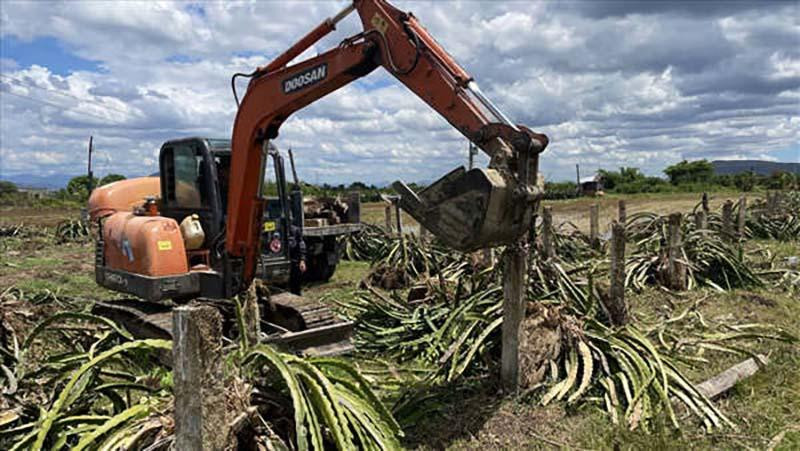
Custom clearance activities at Vietnam-China border gates have resumed. The container trucks carrying farm produce which were stuck for a long time have been cleared. However, after a long period of farm produce export congestion, the price of fruits has been falling sharply.
In the Mekong Delta, it’s now the time to harvest mangos. However, farmers are not bothering to harvest mangos because the prices are too low.
Nong Nghiep Viet Nam reported that merchants only pay VND500 for a kilogram of Taiwanese-variety mangos in the Cai Be ‘mango kingdom’.
Meanwhile, in Co Do district i Can Tho City, Cat Chu mango, the specialty of the locality, is selling at VND8,000-10,000 per kilogram. Farmers offer Taiwanese mangos at just VND500-1,000 per kilogram, but despite the low prices, merchants still don’t want to collect them.
In Cam Lam mango granary in Khanh Hoa province, the Australian-variety mango price has been decreasing for the last month. The mango price reached a peak of VND120,000 per kilogram 6-7 years ago. However, in recent crops, farmers can only break even or take a loss.
First-class mangoes are collected at VND12,000 per kilogram, while second-class are VND4,000 and third-class VND2,000. With these prices, farmers can earn VND5-7 million for one sao (1 sao = 1,000 square meters), while the production cost is VND10 million.
According to the Department of Crop Production under the Ministry of Agriculture and Rural Development (MARD), the total output of eight major fruits in the south in Q2 2022 is estimated at 1.2 million tons, including VND246,600 tons in the southeast region and VND943,500 tons in the Mekong Delta. Meanwhile, the Covid-19 pandemic has affected the export of farm produce, including fruits, since late 2021, which has led to sharp price decreases.
The Import-Export Department of the Ministry of Industry and Trade (MOIT) reported that in Q1 2022, vegetable and fruit export turnover to China decreased sharply to $455.4 million, a drop of 25.3 percent compared with the same period last year. The exports to the market just accounted for 53.6 percent, down 9.5 percentage points.
Since exports to China were stuck, farmers have had to sell products in the domestic market and the oversupply has forced prices down. Dragon fruit, water melon and bananas piled up on sidewalks and were sold for several thousand dong per kilogram.
In late March, bananas, which were reserved for export, were available in the domestic market at just VND5,000-6,000 per kilogram. In some areas, bananas were sold at VND3,000 per kilogram, even cheaper than a glass of ice tea at street tea shops.
An Phuoc rose-apple, a specialty, has seen the price decrease to VND20,000-30,000 per kilogram, while high-quality mangoes have prices of around VND10,000 per kilogram. Cat Chu and Hoa Loc mangoes are a bit more expensive, at VND19,000-25,000 per kilogram.
As exports are at a standstill, farmers are incurring big losses. Many mango growers in Cam Lam no longer take care of crops. They have left the fields uncultivated and leased land to others.
In Binh Thuan, Long An and Tien Giang, dragon fruit was once the major crop which helped local farmers escape poverty and become well off. But things are different now.
Since late 2021, dragon fruit prices have been sliding dramatically as products cannot be exported to China, which caused farmers to take big losses. In Long An, farmers have eliminated 200 hectares of dragon fruit.
In the dragon fruit ‘metropolis’ of Binh Thuan, according to the local department of agriculture and rural development, more than 2,500 hectares of dragon fruit have been chopped down. Of this, 900 hectares are being used for other crops and the other 1,500 hectares have stopped production.
China remains the major market for Vietnam’s fruits and vegetables. Vietnam is allowed to export nine fruits to the market through official channels. However, the majority of vegetables and fruits are still exported to China across border gates.
Every time farm export congestion occurs, experts raise questions: why don’t farmers think of diversifying export markets instead of relying on the Chinese market? Why don’t they focus on the domestic market with 100 million people? Why don’t Vietnamese enterprises think of exporting through official channels? And why don’t they think of processing fruits instead of exporting raw fruit?
Tam An